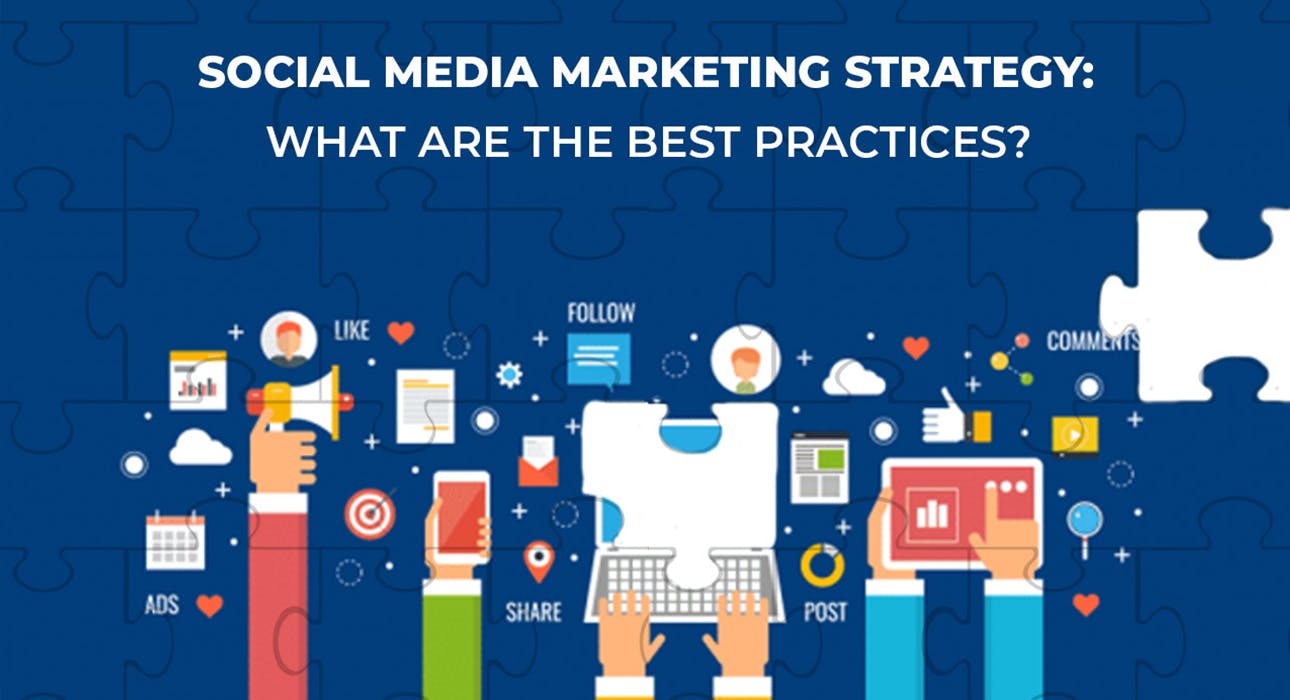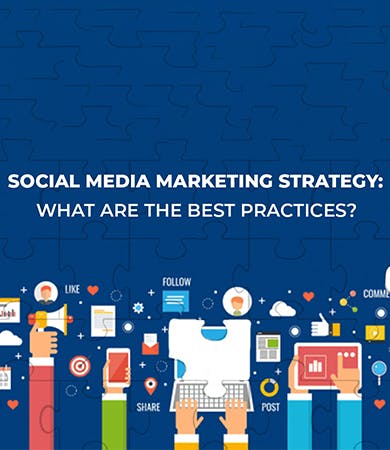How to build your Social media marketing strategy: what are the best practices?

Over 49% of the world’s population uses some form of social media. That’s nearly 4 billion people. By now, you’re probably aware that your brand should have a presence on social media. However, not everyone is clear about what steps they need to take. Or what kind of Social media marketing strategy they need to build or improve their social media presence. There’s no “one magical way” to do social media marketing that works for everyone.
Without a firm Social media marketing strategy backed up by real data. You aren’t going to see the results you want. Also, there are a few universal pitfalls that can sink anyone from which you need to secure yourself. These range from PR nightmares to more seemingly innocuous mistakes, like posting the exact same content on every platform.
In a landscape with more competition, content and networks than ever. A good Social media marketing strategy gives you the focus needed to say “no” to efforts that don’t help you achieve your goals. You should know what does it take for consumers to learn about your brand? Apparently, in this day and age all they need to do is look down at their phones. Consumers or customers are overwhelmed with product information on social media mobile apps and websites these days.
This brand information comes in many different forms. Organic posts, sponsored content from influencers, digital ads, and product listings on a variety of channels. From Instagram to YouTube to Pinterest. As we mentioned before, It goes without saying, that in today’s online economy, a strong social media strategy is essential to running a profitable ecommerce business.
Every brand has its own approach to social media. Some may find that just posting organic content works best for their brand, while others choose to only use it to run ads. At the end of the day just like them. You need to come up with a strategy & test it out to see what works for you. But for that you need to follow the universal or basic practices that every Social media marketer follows.
So, If you’re ready to do better, these best practices in social media marketing will put you on the path to making social media deliver greater business value for your brand. Whether you’re totally new to social or want to double-check your priorities in 2023, this guide has you covered.

Research your audience and set goals:
Social media allows you to both broaden your audience and narrow it at the same time. While you can make your public, organic content available to anyone and everyone on social apps. You can also target your content toward relevant segments of the millions of people who use social platforms every day.
Knowing your customers is one of the most important foundational steps for any marketing campaign. Social media gives us the power to cultivate a massive collection of customer data that we can use to guide business decisions and marketing strategies.
Knowing detailed information about the kind of customer you’re trying to attract via social media will help determine what, where, and when you post content. Based on research, only one percent of companies who regularly tap into their stores of social media & legacy customer data. Actually use it to its full potential. So before you do anything else, you need to identify the target audience for your brand or product.
That’s just a start. Make sure your Social media marketing strategy includes detailed audience research. Document it so your entire team knows exactly who they’re crafting content for. Who is the intended user of your product? What are the characteristics and behaviors of your existing customers? What are their favorite social platforms? When we truly know more about the wants, needs, and expectations of customers, we can anticipate them in real time.
Once you’ve pinned down these details. You can take steps to ensure your content for social media marketing strategy is reaching the right eye. We can also change the very nature of customer service and fundamentally reshape the sales funnel. Thus also shifting the way customers view our brands.
This is basic and 1st reason to research about your target audience is: You can’t build any strategy goals without knowing who you’re trying to attract. Making assumptions is bad news for marketers. Some 60% of organizations use social data daily, according to a latest 2022 research. Both leaders and practitioners can take advantage of the valuable insights social data provides. Defining your target audience is more than demographics or a superficial buyer persona. Include their motivations, inspirations and pain points, and how you’re the perfect solution.
In 2021, the most common goals for social are increasing brand awareness (58%) and increasing community engagement (41%). But in 2022, the main challenges for social media teams included finding talent, proving ROI, social execution, resourcing and using social as a business function.
Whether you want to expand your target area or build a larger following. Taking the time to define your goals is the first step. These goals will define your social media marketing strategy. And how much budget, time and work you’ll need to dedicate to your campaigns.

Choose your Social media marketing strategy platforms:
You don’t need to be on every platform to succeed. Jumping on the newest and the hottest app just because everyone else is doing it, doesn’t mean it will work for you too. Using more platforms is not necessarily better; spreading your efforts over too many channels can end up being a waste of time. While research shows similar rates of overall social media use in the U.S. across gender, income, and education levels, there’s a ton of variation in terms of which age groups use which social media platforms.
Take a look at the latest demographics for your social media marketing strategy and you will find that, these numbers speak directly to which networks your brand should approach and what types of content it should to publish. Facebook and YouTube are both prime places for ads due in part to their high-earning user bases. In 2022, 71% of consumers and 65% of marketers plan on using Facebook the most in the upcoming year. YouTube follows behind with 51% of consumers and 35% of marketers planning to use the platform.
if your target audience is primarily teens, setting up a perfectly-optimized LinkedIn profile for your brand shouldn’t be a priority — you should instead head to the platforms teens actually use, like TikTok. On the other hand, if you’re selling products targeted to parents, you should instead look to Facebook. The top social networks among Millennials and Gen Z are Instagram, Facebook, Tik-Tok, Twitter, Pinterest, YouTube and LinkedIn, signaling the strength of bold, eye-popping content that oozes with personality.
Demographics like the ones above are great for understanding where your target audience lives, but it’s also important to understand the working of each social network so you can decide where your business needs to be. Take a look at which platforms your target audience uses, and make two lists: one with the platforms they use most, and one with the platforms they don’t use as much. Focus on building your social media presence accordingly.
Before opening a new social media account, ask yourself: Do you have the resources to create relevant content for a new platform? Does the purpose of this platform fit your brand? And does your audience spend time here?. Bigger brands with large customer bases tend to have presences across multiple platforms. But, focusing on creating thoughtful content for fewer platforms will always serve you better than posting generic content across every platform.
The platforms you choose will also define the kind of content you want to create. If you produce a lot of videos, you’ll want to share them on YouTube, Instagram, and TikTok. These 3 platforms are great places to garner influencer. But, if you want to build a community around your brand or niche, try Facebook and Pinterest. Last but not the least, LinkedIn can benefit brands who want to target career professionals or other businesses. Most importantly, stay informed on new social media trends, and think before taking action.
After selecting your desired social media platforms, you should claim your handles and usernames before as soon as possible before they’re gone. Your brand name is unique, but its availability as a social media username/handle isn’t guaranteed.
A good practice is to claim your usernames across multiple social media platforms as soon as possible, even if you’re not sure you’ll use them ever in the future. Keep the handles as simple and similar as possible to your brand name across different platforms. So that customers can easily find your official accounts. If you can’t claim your exact brand name, try adding underscore “_”, dot “.”, or the word official in it.

Develop consistent brand guidelines (Brand Voice, tone, Theme or Branding):
No surprises here. Your social media marketing strategy hinges on your content. At this point, you should have a pretty good idea of what to publish based on your goals, audience and brand identity. You probably feel confident in which networks to cover, too. But what about your content strategy? You need two types of rulebooks for your team:
- The visual style, tone, and voice brand guidelines
- Employee social media guidelines
The 1st one ensures your branding remains consistent and recognizable to your audience in everything from visuals to caption style, punctuation choices and overall theme. While, Employee social media guidelines, on the other hand, provide structure to your employees on what topics may be off limits to post about when representing your company, even on their personal accounts.
If your brand hasn’t defined its voice, it’s a good idea to lay out some guidelines for your team. Consider why your brand exists, what it values, how you want to describe your brand, and how you want customers to feel when interacting with your brand.
Your social media accounts are an extension of your brand and should, therefore, align with your other forms of brand messaging. Maintaining a consistent voice helps your brand be recognizable among competitors and stay true to its values. On social media, you can let your brand personality shine. Photo captions, video scripts, live streams, and your bio content each represent great opportunities to make your mission resonate with existing and potential followers.
Use voice and tone to create a specific mood for your brand which is also what people call branding in simple terms. What kind of emotions do you want to elicit from your audience? If your brand was a person, what character traits would they possess? What adjectives do you want your audience to associate with your brand? Let your answers to these questions guide how your brand speaks on social platforms.
If you’re not sure where to start you can have a look at these traits and to get some ideas. .
- Sophistication
- Excitement
- Sincerity
- Competence
- Ruggedness
You can mix and match your emphasis on each of these traits to form a unique identity for your brand. Or, you can even use your customer and competitor research to see how they approach brand voice, and then use that to help determine which sort of brand voice will resonate with your target audience. Use any personas that you generated from customer research to find a voice that speaks to those customers.
From graphics to Reels and beyond, many brands rely on the same content formats and creative touches time and time again. These themes can help you become more consistent and zero in on the Best social media content strategy that makes sense.
Customers hold high expectations regarding how brands should conduct themselves on social media. Study the vocabulary your audience uses and how do they talk about products like yours? Speak the language of your target consumer. If you get these right, your brand could reach viral exponentially, and that will boost your sales greatly.

Choose the right time and amount to post:
It’s important to post consistently to keep your social media content discoverable, at least once a day to keep the content suggestion algorithms on most platforms happy. The specific time of day at which you post matters, too, and varies for each specific channel. Are you still guessing when’s the best time to reach the most people on social? Stop guessing and start using data to tell you when and how much to post instead. You can’t always expect customers to operate on your clock. And timeliness is a tall order when you’re strapped for resources or are part of a small team.
Try posting during peak hours, adjusting your timing until you find the window that earns your content the most engagement. Use social marketing analytics to better understand the performance of your content based on time of day, frequency, geography, and more. Then you can use the insights to adapt your social publishing strategy for optimal performance. Timeliness is arguably more important than ever for marketers. Not only are you expected to put out fresh content regularly, but also to always be “on” for your followers.
- When are my competitors posting content?
- How well does it seem to be working for them?
- What are the responses they are getting?
- How would a different posting rhythm perform?
- How often are my competitors uploading content?
By simply tracking how your audience reacts to the timing of your posts, you can refine your posting strategy to take advantage of the most advantageous and favourable posting times. Furthermore, Manually publishing posts each day can get annoying. Also, don’t be a Last Minute Melvin. Coming up with content right before you need to post it is a recipe for burnout. Planning your content for Social media marketing strategy in advance gives you the time & space, and allows you to create high-quality content. Logically put together marketing campaigns, and seek collaboration and feedback from your team.
Thankfully, there are a ton of scheduling apps available to keep you on track. Tools like Creator Studio, Meta, Later, ifttt and other calendar
Apps let you schedule social posts across different platforms, visually plan your feeds, and discover optimal times to post through engagement data analytics.
Use a content calendar to plan out your posts and stay organized. Knowing in advance what you’re going to post will save you a lot of time and keeps you from posting the same pieces of content too frequently. It will also let you see what your social media feed will look like after a week of consistent posting. You should also stay on top of the trending news in your niche, so you can post timely updates or reactions to events and stories your audience is following. You can set Google alerts for keywords related to your brand or industry, and follow relevant hashtags and accounts on Instagram and Twitter.

Respond to your customer questions and shout-outs promptly:
Always remember that social media is a customer service channel. Take advantage of your proximity to shoppers and use social channels as an outlet for customer support. Answer questions, thank users for positive feedback, and have a plan for handling sticky situations. Speed is crucial to maintaining a happy customer base.
Customers have high expectations for a quick response. Your customers want speedy responses. More than three-quarters of consumers expect a response within 24 hours. Half of which expect a brand to respond to their tweet demand a response within three hours. 22% of social media users expect a response between 1-12 hours.
Besides tagging you in a post, users are also messaging you or leaving comments on your social media posts with customer service inquiries. Those important comments are easy to miss, especially if your posts get hundreds of comments. Not surprisingly, over 40% of customers who reach out to brands on social media are more likely to buy and encourage their friends and families to buy from companies who provide them with a timely response.
74% of younger people (gen Z and millennials) don’t like being repeatedly targeted by brands on social media. Building trust with these generations involves a two-way dialogue. They want an experience that feels organic and authentic. The best way to build trust is to talk with them and reply them promptly. Brands who fail to meet this expectation risk losing customers. About 30% of customers said they would stop giving a brand their business and express their dissatisfaction both on social media and to friends and family.
The internet can be an unkind place for brands, where dunking on official accounts yields its own kind of social currency. Spend five minutes browsing recently-posted Tweets about any gains business and you’ll see what I mean.
As a business owner, you’re bound to run into the occasional bit of negative feedback on social media, whether it’s a mean tweet or a rude YouTube comment complaining about your products or service. you gain respect as a brand by being present and talking to your audience. That’s why social customer care is so important to brands wanting to increase audience awareness word travels fast about great service.
There’s a difference between a few negative comments and a full-blown public relations nightmare. Whether the backlash you receive is legit or not, you need to have a plan for dealing with crises:
- Who on your team will lead the response?
- What will your response be?
- Will you make a public statement about it?
- Will you respond to individual comments or direct people to a prepared statement?
- Will you change the policy or action that people are upset about? And if so, how will you announce that?
- Will you go extra mile to solve the issue?
- Will you be willing to provide any compensation or good will gesture if its legit issue? Even if the mistake is not from your end?
Hopefully, conducting your daily operations ethically, responsibly, and inclusively will avoid situations like this, but it’s best to have a plan. And always remember there is the only rule you need to remember when dealing with internet hate: kill them with kindness. Respond to angry comments with empathy, and always lead with an apology and direct action to fix or resolve the issue.
To avoid a high-visibility dispute in public comments, send the unhappy account a direct message. That way, you can soothe the angry customer, troubleshoot a problem, and prevent further issues from happening in the future. Users won’t always tag you in their complaints on social media. So, always keep an eye out for mentions of your brand by monitoring relevant keywords and hashtags.
When your customers experience satisfactory resolution to specific issues, and in particular those using social channels, ask that customer if you can share those conversations or if they would like to leave a review. This also improves your brand image and allow new users/customers to be more interactive with their queries without any hesitation.

Start working on your social media marketing strategy:
Being popular on social media and creating viral content is every marketer’s summer’s dream. However, without planning and a clear view about your goals, you won’t make it. Using social media in marketing does more than improve site traffic and increase your reach. It turns your business into a personality that your audience can communicate and connect with on a deeper level.
If you intend to grow and maintain a presence on multiple social media platforms, keep in mind their unique characteristics. Consider these specific approaches and best practices for managing your social media presence across different channels. Although determining your company’s social media course of action may seem daunting, you can avoid feeling overwhelmed by understanding social media marketing trends and using some of the many resources available about the topic. Just remember, that social media platforms are continuously changing, merging new updates and ideas, trends and views that alter users’ perceptions.
Regardless of which platforms you use or how you use them, the most important thing to remember is that social media is not a platform to pitch your business. It’s a community for you to express your personality, demonstrate your values, share useful information, and build up those around you.
Hopefully these tips and tricks come in handy when developing your social media strategy. In case you have any questions, we’d be glad to help you. We are only a few clicks away.







